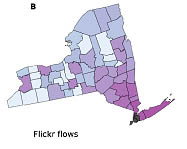EPJ Data Science Highlight - Mining digital crumbs helps predict crowds’ mobility
- Details
- Published on 02 November 2016

Analysing the traces of human behaviour from geolocalisation data gives clues for more accurate urban planning
Getting urban planning right is no mean feat. It requires understanding how and when people travel between different places. This knowledge, in turn, helps in dimensioning roads and motorways and in scaling the capacity of utilities, such as power grids or mobile phone towers. Now, physicists at the Institute for Scientific Interchange Foundation in Turin, Italy, have exploited the geolocalisation data from millions of users of the photo sharing site Flickr to show how it is possible to predict crowd movements. Mariano Beiró and colleagues have combined this data with existing theoretical models explaining the movement of people. In a study published in EPJ Data Science, they show that their approach can help improve predictions concerning the nature of travel of large crowds of people between two places.
Previously, social scientists proposed some theoretical models to explain how the flows of people or goods between cities are related to population distribution, economic development or travel distance. Thanks to geolocalisation, these last 50 years of static modelling can now be refined. In this study, the authors have thus combined them with actual digital crumbs left by social media users showing how people travel in the USA at different scales of distance.
To do so, they used a hybrid algorithm based on machine learning and capable of integrating patterns by processing available data to infer results when data is not available. Beiró and colleagues thus showed how predictions of how many people fly between airports, or commute between two counties, can be improved. Future research could extend these methods to real-time predictions of the collective flows of people, as data becomes more widely and more rapidly accessible. This will help avoid potential traffic congestion or resource shortages due to an emergency situation, for example.
Mariano G. Beiró, André Panisson, Michele Tizzoni, Ciro Cattuto (2016), Predicting human mobility through the assimilation of social media traces into mobility models, EPJ Data Science, 5:30, DOI 10.1140/epjds/s13688-016-0092-2





